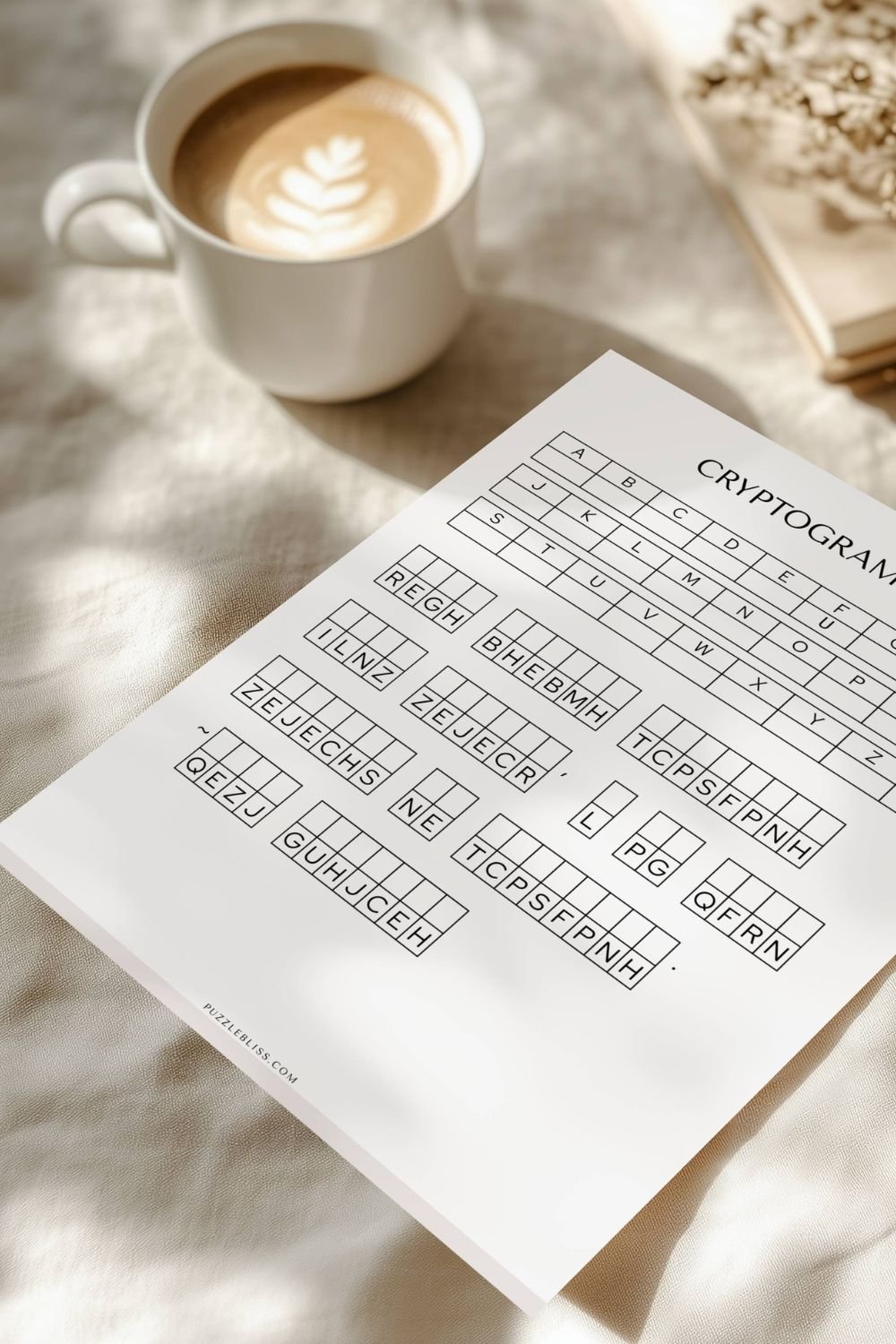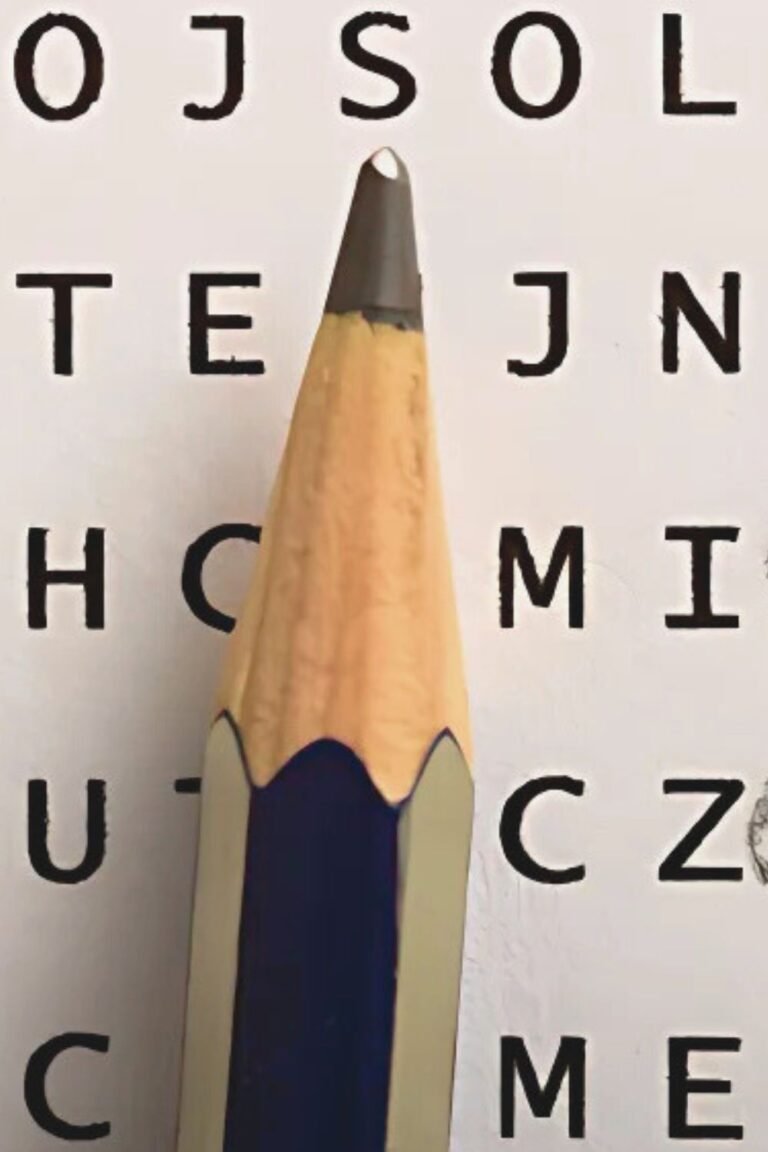Cryptogram Puzzles
Cryptogram Puzzles: Unlock the Secrets of Coded Messages
Why We Love Cryptogram Puzzles
There’s something undeniably thrilling about cracking a secret code—a sense of mystery, discovery, and intellectual challenge that makes solving a cryptogram feel like unlocking a hidden message from the past. Whether you’re deciphering an encrypted note from a long-lost treasure map or simply solving a daily brain teaser, cryptograms are one of the most intriguing and rewarding puzzles ever created.
At Puzzle Bliss, you get the chance to step into the role of a codebreaker, solving word-based ciphers designed to test your logic, boost your problem-solving skills, and keep your mind sharp. Unlike traditional word puzzles where the answer is hidden in plain sight, cryptograms require you to think critically and recognize patterns before the puzzle starts to make sense. That moment when the letters fall into place? It’s pure magic—and a feeling that keeps cryptogram puzzle lovers coming back for more.
So why do we love cryptograms so much? The answer lies in our brain’s natural desire for pattern recognition. The human mind is wired to find order in chaos, which is why we’re drawn to solving word puzzles, cracking secret codes, and uncovering hidden messages. When you download printable cryptogram puzzles, you’re not just solving a puzzle—you’re engaging in a timeless mental exercise that has been used by spies, historians, and puzzle enthusiasts for centuries.
Whether you’re new to codebreaking or a seasoned solver, cryptograms provide a unique mix of mystery, challenge, and intellectual satisfaction. If you’re ready to experience the exhilaration of decoding a message from scratch, let’s dive into how cryptograms work and why they’ve captivated puzzle lovers for generations.
love puzzles like we do?
Subscribe for amazing deals and special offers!
How A Cryptogram Works
A Secret Code Waiting to Be Solved
Every cryptogram is a puzzle wrapped inside a mystery—a scrambled message that hides a real phrase, quote, or sentence beneath a layer of encoded letters. At first glance, it might seem impossible to decipher, but once you learn how to spot key letter patterns and substitutions, the entire puzzle starts to unfold before your eyes.
At Puzzle Bliss, we offer a wide range of printable cryptogram puzzles that challenge you to break the code using pure logic and letter frequency analysis—no outside hints, just your brainpower. But how exactly does a cryptogram work? Let’s break it down.
Letter Substitutions
The Core of Cryptograms
In most cryptograms, each letter of the alphabet is replaced by another letter, creating what looks like a meaningless jumble of text. For example, the phrase:
“SOLVING PUZZLES IS FUN”
…might be encoded as:
“QKFOKGT NRXNXJX FT ZYS”
At first, this seems completely unreadable. But with careful analysis, you can spot recurring letter patterns, common words, and logical placements that help you crack the code.
Cryptogram puzzle solving
Not sure where to start? Every cryptogram leaves behind tiny clues that can help you decode the message faster. Here’s what to look for:
- Single-letter words – In English, a one-letter word is almost always A or I.
- Common two-letter words – Look for words like TO, IN, IS, AN, OR, AT, which frequently appear in cryptograms.
- Frequent letters – The most commonly used letters in English are E, T, A, O, I, N, S—these are likely to appear the most in the puzzle.
- Double letters – If you see a repeated letter (XX, YY, etc.), it’s probably a common pair like LL, EE, or SS.
At Puzzle Bliss, our cryptogram online puzzles are designed to test your skills while still being fun and solvable—no frustrating dead ends, just pure word-deciphering excitement!
Cryptographic Methods
Used in History
Cryptograms aren’t just a fun game—they’re a part of history. The techniques used in modern word-based ciphers are rooted in real-world encryption methods used by spies, governments, and secret societies. Here are some of the most famous cryptographic systems:
- The Caesar Cipher – A simple letter-shifting technique used by Julius Caesar to protect military messages.
- The Atbash Cipher – An ancient encryption method where the alphabet is reversed (A = Z, B = Y, etc.).
- The Pigpen Cipher – A geometric substitution cipher used by the Freemasons to encode secret messages.
- The Enigma Machine – The famous cipher used by the Nazis in WWII, eventually cracked by Alan Turing’s team.
When you solve a cryptogram, you’re participating in a centuries-old tradition of secret communication and decryption. It’s a puzzle, yes—but it’s also a glimpse into the fascinating world of cryptography.
Are You Ready to Crack the Code?
Now that you know how cryptograms work, it’s time to put your codebreaking skills to the test. Whether you’re a beginner looking for an easy puzzle or an experienced solver ready for a challenge, you’ll find plenty of mind-bending cryptograms waiting for you in our printable cryptogram puzzle books.
Can you crack today’s puzzle?
There’s only one way to find out!
A new puzzle each day
daily cryptogram
Your fun printable cryptogram puzzle. Simple download, print, and enjoy immediately. No waiting! Click the link below to visit our Daily Cryptogram to today’s puzzle. Happy puzzling!

Secrets of a Codebreaker
How to Solve Cryptograms Faster
You don’t need to be a trained spy or a genius mathematician to crack a cryptogram. With the right approach, anyone can become a skilled codebreaker. The trick is knowing where to start, how to spot hidden patterns, and which strategies to use when a puzzle seems impossible. Whether you’re deciphering an easy substitution cipher or tackling a more advanced encoded message, these expert techniques will help you solve cryptograms faster and with greater confidence.
Spot the Most Common Letters First
Every language has high-frequency letters that appear far more often than others. In English, the most commonly used letters are:
E, T, A, O, I, N, S, H, R, D, and L
If you see a letter appearing frequently in the cryptogram, chances are it represents one of these. Start by identifying repeated characters and testing them against common words.
Pro Tip: The letter E is the most used letter in the English language. If one letter appears more often than others, there’s a good chance it’s an E!
Look for Single-Letter Words
In almost every cryptogram, you’ll find one-letter words—which, in English, are almost always:
A
I
By identifying single-letter words, you’ve already decoded part of the puzzle, making the rest of the process easier.
Search for Common Short Words
Certain two- and three-letter words appear frequently in English writing. If you spot a short word that appears more than once in the cryptogram, it’s likely to be:
✔ TO, IN, IT, IS, AT, OR, AN, ON, BY (two-letter words)
✔ THE, AND, FOR, BUT, NOT, YOU, CAN, ARE, ALL (three-letter words)
Replacing these short words with their corresponding letters reveals even more of the hidden message.
Identify Double Letters
If you see two identical letters placed together (XX, YY, TT, etc.), they are likely one of these common letter pairs:
LL, EE, OO, SS, TT, FF, RR, NN, PP
For example, if a cryptogram contains “GXXD,” chances are the correct word is “GOOD.”
Use Context Clues & Word Structure
Once you’ve uncovered a few words, start thinking about what kind of message the cryptogram is hiding. Many cryptograms are quotes, famous sayings, or inspirational messages, which means you can predict possible words based on context.
For example, if you decipher “LIFE IS B—–L,” chances are the missing word is “BEAUTIFUL.”
The ‘Wheel of Fortune’ Method
If you’re completely stuck, think of it like a game of Wheel of Fortune—start filling in the most common letters in the English language:
🅴 🆃 🅰 🅾 🅸 🅽 🆂 🅷 🆁
By placing these letters into the puzzle and testing different combinations, you’ll quickly reveal more of the message.
Take a Break
Return with Fresh Eyes
If you’ve spent a long time on one cryptogram without making progress, step away and come back later. When you return, your brain processes the puzzle differently, and you might spot new patterns that weren’t obvious before.
Pro Tip: If you’ve been staring at the puzzle for too long, try reading it backward—sometimes, a fresh perspective is all you need!
The Psychology of Cryptograms
Why Your Brain Loves a Challenge
You may think you’re just playing a game, but solving cryptograms is actually a powerful mental workout. Every time you decode a message, your brain engages multiple cognitive functions, strengthening memory, logic, and problem-solving skills. In fact, studies show that regularly solving word puzzles can slow cognitive decline, improve mental agility, and enhance overall brain health.
The Science of Pattern Recognition
Your brain is wired to find order in chaos. When you see a cryptogram, your mind automatically starts looking for recognizable patterns, even before you actively start solving. This is called pattern recognition, a critical function used in reading, learning, and decision-making.
Brain Fact: Neuroscientists have found that puzzles like cryptograms activate the prefrontal cortex, the part of the brain responsible for problem-solving and logical reasoning.
Cryptograms Strengthen Memory & Focus
Deciphering a cryptogram requires holding multiple possibilities in your mind at once, which strengthens working memory—the ability to store and manipulate information.
How Cryptograms Improve Memory:
- Enhance recall skills – The more puzzles you solve, the faster you recognize letter patterns.
- Train concentration – Solving cryptograms requires deep focus and attention to detail.
- Boost mental flexibility – Your brain learns to adapt quickly to new information.
Fun Challenge: Try solving a cryptogram without writing anything down—this forces your brain to hold and rearrange letter sequences entirely in your head!
The Dopamine Effect
Why Puzzles Feel So Satisfying
Ever noticed how good it feels when you crack a tough cryptogram? That’s dopamine at work. Dopamine is the “reward chemical” in your brain, released when you experience success or solve a difficult problem. Each small victory—deciphering a letter, forming a word, or solving the entire cryptogram—creates a sense of accomplishment that makes you want to keep going. This is why puzzles can be so addicting—they activate the same brain pathways as learning a new skill or achieving a personal goal.
Try This: Time yourself while solving cryptograms and challenge yourself to beat your best time—the faster you decode, the more dopamine your brain releases!
Cryptograms as Meditation & Stress Relief
Did you know that solving puzzles can reduce stress? Cryptograms require deep focus and concentration, which helps quiet anxious thoughts and promote mindfulness.
How Cryptograms Reduce Stress:
- Focuses your mind on a single task, reducing mental clutter.
- Encourages a state of “flow,” where you’re fully engaged in the activity.
- Provides a screen-free way to relax and unwind.
Try This: Instead of scrolling through your phone at night, solve a cryptogram as a way to calm your mind before bed.
Strengthens Your Brain!
The next time you solve a cryptogram, remember—you’re not just playing a game, you’re giving your brain a serious workout. From pattern recognition to problem-solving, memory training to stress relief, cryptograms provide a fun, rewarding, and scientifically proven way to keep your mind sharp.
Let’s Play!
Now that you know how cryptograms work and why they’re so beneficial, it’s time to put your skills to the test! Download Printable Cryptogram Puzzles and Start Solving Today!
Join the list!
Get subscriber-only deals and special offers – right in your inbox!





